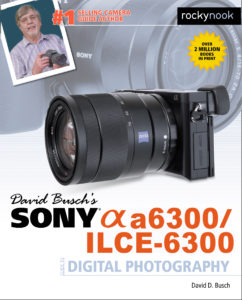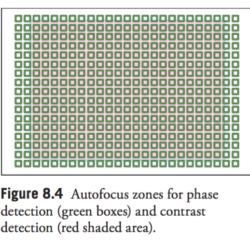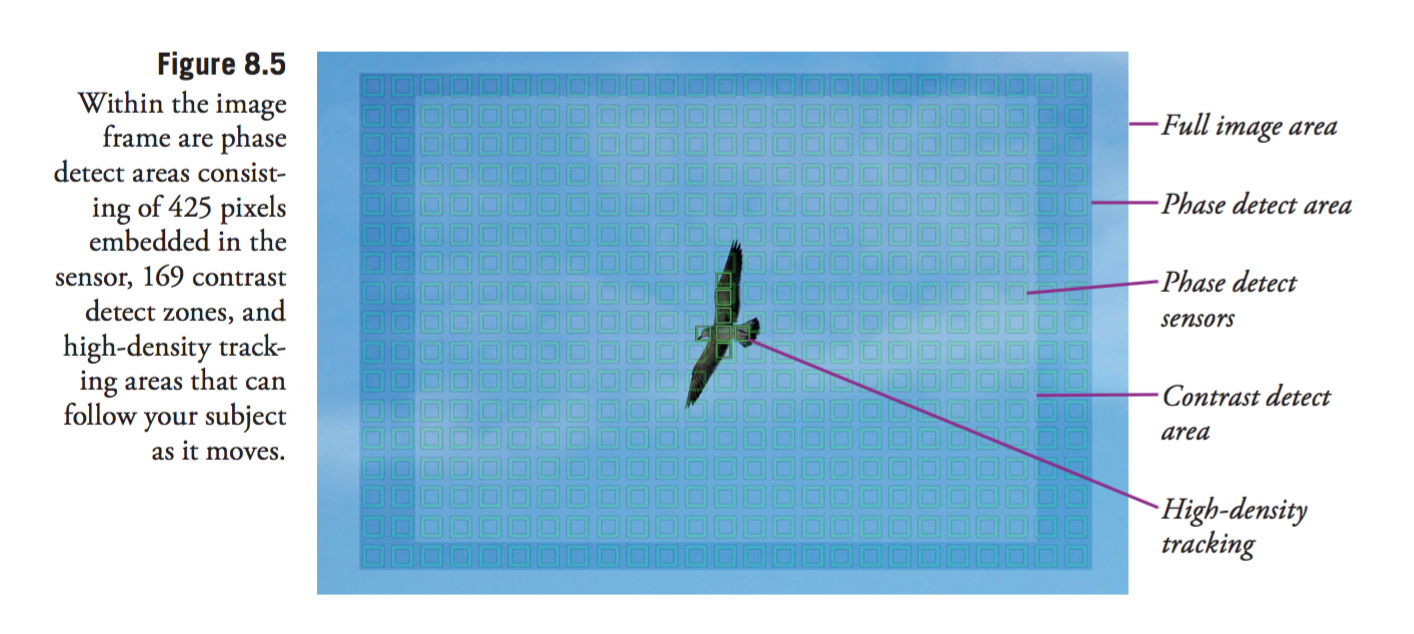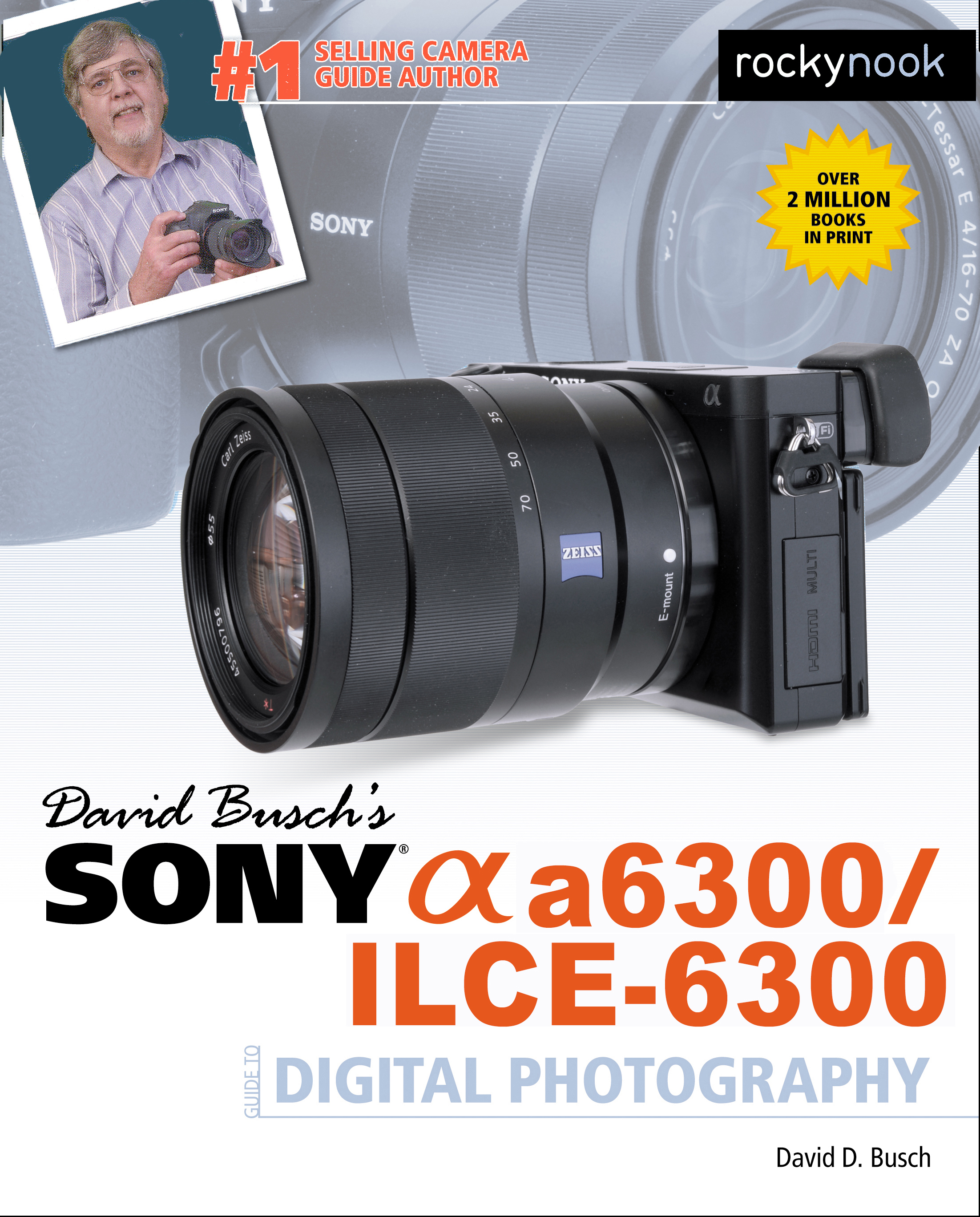Explained: Sony A6300 Hybrid Autofocus May 31, 2016 – Posted in: Photography – Tags: a6300 auto focus, david busch sony a6300, sony a6300
David Busch’s Sony Alpha a6300/ILCE-6300 Guide to Digital Photography is now available! This highly anticipated guide is your ultimate roadmap to Sony’s advanced APS-C mirrorless camera. Scroll down to find a sneak peak at what this guide has to offer!
Explained: Sony A6300 Hybrid Autofocus
Sony a6300 autofocus uses both phase detection autofocus (PDAF) and contrast detection autofocus (CDAF) to provide a combination of fast and accurate AF. Figure 8.4 shows the layout of the autofocus points and zones used by the a6300.
Phase detection points. The green squares in the figure represent the approximate  location of 425 phase detect points embedded in the a6300’s sensor (a matrix measuring 25 × 17). These pixels cover almost all of the frame. That can be important for sports photographers, who may have subjects in all parts of the image. As I write this, Sony has not released figures detailing the percentage of the frame covered by PDAF, but my quick-and-dirty calculations estimate that fully 81 percent of the frame can be used for phase detect AF. That’s outstanding.
location of 425 phase detect points embedded in the a6300’s sensor (a matrix measuring 25 × 17). These pixels cover almost all of the frame. That can be important for sports photographers, who may have subjects in all parts of the image. As I write this, Sony has not released figures detailing the percentage of the frame covered by PDAF, but my quick-and-dirty calculations estimate that fully 81 percent of the frame can be used for phase detect AF. That’s outstanding.

Contrast detection zone. The shaded red area represents the sensor area that contains the 169 separate contrast detection zones (they are not individual pixels). While the CDAF area is smaller than the PDAF coverage, approximately 73 percent of the frame is accounted for, concentrated in the center area.
The hybrid autofocus system of the a6300 uses both types of AF. The camera begins by rapidly focusing using PDAF, because the rangefinder approach always tells the camera whether to move focus closer or farther, and by approximately how much. No hunting is required, which is often the case with contrast detection, which needs to tweak the focus point until it settles on the sharpest position.
Once the PDAF has done its stuff, contrast detection kicks in, using its finicky but more accurate focusing capabilities to fine-tune focus. So, you end up with speedy initial focus (PDAF) and slightly slower final adjustments (CDAF), providing a perfect hybrid compromise. That’s why Sony didn’t switch to phase detection completely. Here’s a quick rundown of the advantages of a hybrid system:
- Contrast detection works with more image types. Contrast detection doesn’t require subject matter to have lines that are at angles to the PDAF points to work optimally, as phase detection does. Any subject that has edges running in any direction can be used to achieve sharp focus.
- Contrast detection can focus on larger areas of the scene. Whereas phase detection focus can be achieved only at the points that fall on one of the special autofocus sensor pixels, with contrast detection much larger portions of the image can be used as focus zones. Focus is achieved with the actual sensor image, so focus point selection is simply a matter of choosing which part of the sensor image to use. (This point is highlighted by the fact, discussed below, that in Flexible Spot mode, you can move the Autofocus Area to many parts of the sensor, whereas with a phase detection system, you can move the Autofocus Area only to the specific locations where the special autofocus sensors used for phase detection are located.)
- Contrast detection can be more accurate with some types of scenes. Phase detection can fall prey to the vagaries of uncooperative subject matter: if suitable lines aren’t available, the system may achieve less than optimal focus. In addition, accuracy decreases as the maximum aperture baseline used for calculations becomes smaller. Although AF is always conducted with the lens wide open, a lens with a maximum aperture of f/5.6 will focus with less accuracy than one with an f/1.4 maximum aperture. Contrast detection focus is more clear-cut. In most cases, the camera is able to determine clearly when sharp focus has been achieved.
- Phase detection “knows” which direction to focus. The split image seen by phase detection sensors reveal instantly whether focus is too close or too far. As I mentioned earlier, there is no need to “hunt” for the focus point, as the AF system can immediately adjust in the proper direction. That boosts focus speed considerably.
- Phase detection “knows” how far out of focus a subject is. The separation between the two halves of the image let the AF system know whether the subject is grossly out of focus, or whether only a slight adjustment is needed. That means faster autofocus, too.
- Phase detection isn’t as dependent on scene brightness. As long as the split images are illuminated well enough for the AF system to make an evaluation, greater or lesser amounts of light don’t have as much of an effect on speed and accuracy. Remember, the reason phase detect systems operate less well at smaller f/stops is because the baseline diameter of the aperture is smaller.
- Sony’s 4D high-density tracking can follow moving subjects. The a6300’s phase detection system can achieve focus quickly (even when shooting continuously at 11 frames per second), whether your subject is moving horizontally or vertically (what Sony calls area), toward you, or away from you (depth in Sony-speak). To those three dimensions, the system adds the fourth dimension of time (which the company labels as steadfast), so focus can be maintained as it changes position. The 4D AF also deploys high-density tracking to zero in on moving subjects, using focus areas that are smaller than the 425 phase detect sensor areas shown in Figure 8.5.

Discover even more tips, tricks, and explanations in David Busch’s Sony Alpha a6300/ILCE-6300 Guide to Digital Photography – Available now in digital format! Save 35% with coupon code 35A6300



